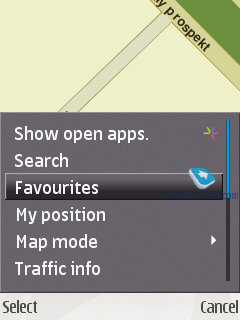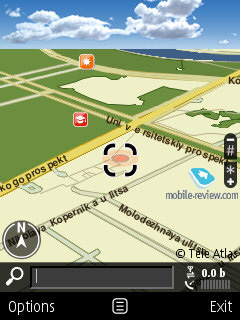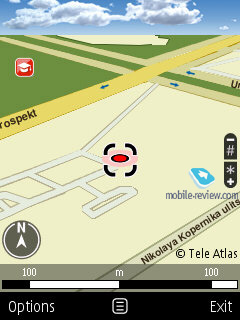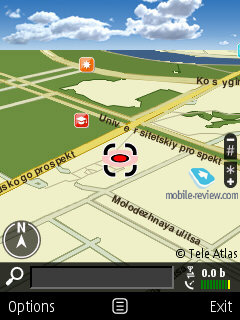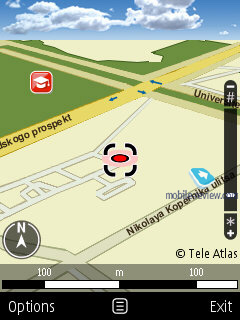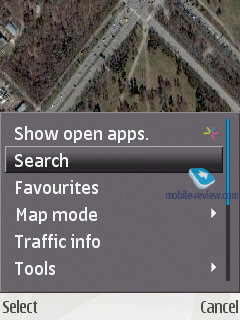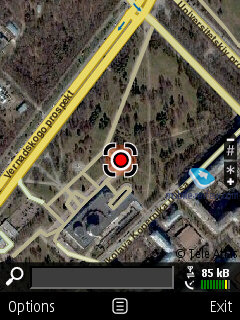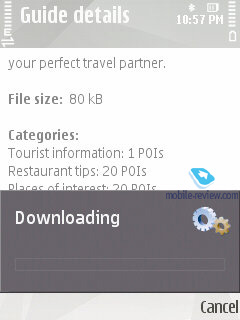|
|
Review of GSM/UMTS-smartphone Nokia 6220 Classic
Live images of the Nokia 6220 Classic
Table of Contents:
- Positioning
- Design, Size, Controls
- Display
- Keypad
- Battery
- Memory
- Performance
- USB, Bluetooth
- Camera
- GPS-navigation
- Impressions
Sales package:
- Handset
- 900 mAh Li-Pol battery (BP-5M)
- Wired stereo-headset (HS-47)
- Charger (AC-5)
- USB data cable (CA-101)
- 1 Gb microSD memoy card (coming included with Nokia Maps and a 90-day trial)
- Nokia Video-Out Cable CA-92U
- User Guide
- Software CD
Positioning
In essence, the arrival of the Nokia 6220 Classic was entirely thanks to NokiaТs current strategy basing on the economy of scale, where they aimed to churn out as many models utilizing some particular hardware as possible in order to cut total expenditure. As far as the imaging department goes, the piece of hardware in question is the 5 Mpix CMOS module Ц descending from its flagship offerings to the lower end of the market, Nokia have implemented it in several handsets, varying in price range. It all started with the Nokia N95 in all its iterations, that was followed by the Nokia N82 (which actually set a new price record for top-notch 5 Mpix shooters); these days Nokia are tackling the 300-375 Euro segment (prices at launch), which they are going to fill with a variety of solutions that will differ in some details, such as flash type (xenon or LED). Although they are planning to release a bunch of phones in this price bracket before the end of 2008, in my opinion the heap will still be topped by the Nokia N82; but those who didn't like for some reasons will get some alternatives to choose from, which is all good.

One could waste a lot of time, pondering over what phones can be considered worthy spin-offs, but the bottom line is this: the Nokia 6220 Classic is less sophisticated than the Nokia N82 and given their identical price tags, the latter is definitely a superior choice. HHowever, the 6220 Classic also has several things going for it, such as: a new design, and a steeper price curve, that will result in a substantial price cut by the end of this year. Combined, these two factors lend the phone pretty good potential. Plus the number of differences between the 6220 Classic and the N82 is just enough to make sure we won't keep looking back at their camera modules alone throughout this review.

The phone's index, as well as the "Classic" suffix clearly indicate that the 6220 Classic is aimed at the average consumer, who just wants to have a potent cameraphone with no other bells and whistles. While this approach is quite unconventional, the phone will sell among all age groups and will be regarded more as a feature phone with a decent camera.
Back to the table of contents>>>
Design, Size, Controls
The 6220 Classic in a choice of two colors - dark grey (although in this trim the front fascia is black and glossy) and blue. All in all, these color schemes fit the handset's unpretentious nature very well.

The 6220 Classic is one of the first phones to sport a ceramic-esque back finishing - it is a bit on the rough side and doesn't wear out too quickly, plus it's more practical than a glossy coating, as this type of plastic doesn't pick up grease, smudge or particularly discernible scratches and nicks.

The handset measures up at 108x46.5x15.2 mm and weighs 90 grams, which is smaller than the Nokia N82, but don't forget the 6220 Classic's tinier display, lower-capacity battery and absence of some hardware components inside.







Perched on the left is the shortcut button that may be reassigned to any application of your choosing (by default it calls up Maps). When navigating, the LED sitting next to this key starts blinking. On the right there is the 6220's volume rocker along with a dedicated camera button. Mounted on the top end are the power key and 2.5mm headset jack.


On the back there is a 5 Mpix camera lends along with a flash; the good thing about the 6220 Classic's camera is that its cover is on the stiffer side and won't slide open accidentally.

Back to the table of contents >>>
Display
The handset comes equipped with 2.2-inch QVGA display (240x320 pixels, 32x46 mm), which is a bit smaller than that found in the Nokia N82. But this doesn't hurt the 6220 Classic screen's performance in any away, as it is capable of up to 16 million colors and always shows a bright and crisp picture.
All in all, we liked how the 6220 Classic performed on this front. Also, it's display can accommodate up 8 text and 3 service lines, although in some modes there can be as many as 14 lines of text.

Back to the table of contents >>>
Keypad
All buttons on the 6220 Classic are made of glossy plastic, and generally are pretty responsive and easy to use. First shipments of the Nokia 6220 Classic had some issues with their keypads, but luckily as of today all of them have been dealt with. But in case you stumble upon a defect, you should take your phone to a service center, where it will be repaired free of charge.


Back to the table of contents >>>
Battery
The handset utilizes a 900 mAh Li-Ion battery (BP-5M), as opposed to the Nokia N82's 1050 mAh cell. The 6220 Classic is rated for 5 hours of talk time and 300 hours of standby. Music time - up to 13 hours. Video recording time (in top resolution and quality) - up to 120 minutes, while the phone's video playback time is quoted at 280 minutes.


The handset's battery life averaged 3 days in our tests, when we used the 6220 Classic for about an hour and a half of calls, a dozen or two snaps, several minutes of video, and around an hour of music/radio. It takes the 6220 Classic around 1 hour to charge from empty to full.
Below is our chart of battery times we managed to squeeze out of the 6220 Classic:
- GPS-navigation Ц 3.5-4 hours
- Video - 4 hours 45 minutes
- WEB-browsing (via EDGE) - 3 hours
- Music (in earphones) - 14 hours
- Radio Ц 12.5 hours
- Games Ц 4.5 hours
Thanks to its latest and greatest Feature Pack 2, the 6220 Classic has become less power-hungry in some modes, and even manages to improve over the numbers of the Nokia N82 (although their WEB-browsing times are identical).
Back to the table of contents >>>
Memory
The device comes equipped with 128 Mb of RAM, after first launch you will get around 80 Mb of free memory at your disposal, which is enough for running a dozen applications and browsing "heavy" web-pages - the word "slow-down" is definitely not in the 6220 Classic's vocabulary.
The user almost has 120 Mb of storage available, where any data can be stored.
The 6220 Classic deals with microSD memory cards (hot-swappable), the phone comes packaged with a 1Gb unit. There are no restrictions as far as memory card's size is concerned - our handset easily identified a 8Gb card.
Back to the table of contents >>>
Performance
Effectively, the 6220 is no different from the Nokia N82 on this front - all test results appear to be exactly the same. All in all, the 6220 Classic is a generic S60 solution with no remarkable positives or negatives.
Back to the table of contents >>>
USB, Bluetooth
USB. You pick one of these 3 connection modes in the USB settings of the 6220 Classic:
- Data Transfer (Mass Storage USB) Ц memory cards is available, no drivers required, as your OS identifies the handset automatically.
- PC Suite Ц used for device management via Nokia PC Suite, enables all features of the phone, data backup etc
- Image Print Ц no explanation required.
Data transfer speeds on the 6220 Classic top out at around 2 Mb/s.
Bluetooth. The phone comes with Bluetooth v2.0, with support for EDR. The following profiles are supported:
- A2DP
- AVCRP
- BIP-ImagePush
- DUN-GW
- FT-Server
- HandsFree-AG (1.0)
- Headset-AG
- OBEX
- OPP-Client
- OPP-Server
- SIM Access-Server
The top speed you can get with the 6220's Bluetooth connection is around 100 Kb/s. We also tested its A2DP profile in pair with the Sony Ericsson DS970 headset, which worked just fine - we managed our play list, skipped within tracks and adjusted volume seamlessly, however we couldn't make current track's title show up on the 6220 Classic's display.
Back to the table of contents >>>
Camera
The 6220 Classic comes equipped with a 5 Mpix camera module and Xenon flash, just like in the Nokia N82. In fact, it's an exact copy of the latter, it doesn't even differ from software-wise. The only enchancement we noticed was geo-tagging functionality, that allowed viewing all snaps we made on the map. Another thing of note about the 6220 Classic's camera is that you can setup the shortcut bar as you please.
The 6220 Classic's top resolution is Print 5M - large, which stands for 2592x1944 pixels and image size of 700Kb-2Mb. The user can also make use of the following resolution settings:
- Print 3M Ц Medium (2048x1536 pixels)
- Print 2 M- Medium (1600x1200 pixels)
- E-mail 0.8 M Ц Med. (1024x768 pixels)
- MMS 0.3 M Ц Small (640x480 pixels)
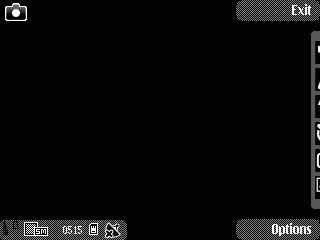
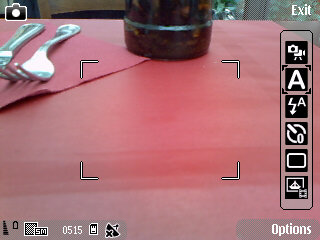
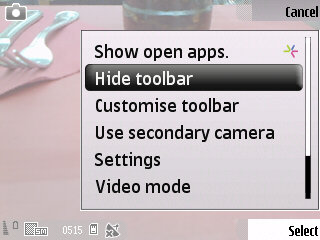




Time required to save a shot in any of these resolutions is 3-4 seconds if you have enabled after-shoot view. Or 1-2 seconds in case you are ready to take another snap right after that (in the latter case shots are saved from the buffer).
Color tones. Since these overlays can be applied to any snap in a standard graphics editor, it won't be wise of you to enable them for taking a snap on the 6220 Classic. There are four effects available - Sepia, Black & White, Vivid, Negative.
Exposure compensation. Exposure compensation. This parameter is adjusted at a 0.5 step here; it will prove useful for shooting objects with dominating light or dark tones.
White balance. The 6220 Classic's camera does very well in the auto mode, though you can manually adjust the white balance and choose one of the following settings - Sunny, Cloudy, Incandescent, Fluorescent.
 |
 |
| (+) enlarge, 2592x1944, JPEG |
(+) enlarge, 2592x1944, JPEG |
 |
 |
| (+) enlarge, 2592x1944, JPEG |
(+) enlarge, 2592x1944, JPEG |
 |
 |
| (+) enlarge, 2592x1944, JPEG |
(+) enlarge, 2592x1944, JPEG |
 |
 |
| (+) enlarge, 2592x1944, JPEG |
(+) enlarge, 2592x1944, JPEG |
 |
 |
| (+) enlarge, 2592x1944, JPEG |
(+) enlarge, 2592x1944, JPEG |
 |
 |
| (+) enlarge, 2592x1944, JPEG |
(+) enlarge, 2592x1944, JPEG |
 |
 |
| (+) enlarge, 2592x1944, JPEG |
(+) enlarge, 2592x1944, JPEG |
 |
 |
| (+) enlarge, 2592x1944, JPEG |
(+) enlarge, 2592x1944, JPEG |
 |
 |
| (+) enlarge, 2592x1944, JPEG |
(+) enlarge, 2592x1944, JPEG |
 |
 |
| (+) enlarge, 2592x1944, JPEG |
(+) enlarge, 2592x1944, JPEG |
 |
 |
| (+) enlarge, 2592x1944, JPEG |
(+) enlarge, 2592x1944, JPEG |
 |
 |
| (+) enlarge, 2592x1944, JPEG |
(+) enlarge, 2592x1944, JPEG |
 |
 |
| (+) enlarge, 2592x1944, JPEG |
(+) enlarge, 2592x1944, JPEG |
Vdeo
The handset is capable of shooting video in a number of quality modes, with the best one putting up 15 frames per second at 640x480 (VGA resolution). All clips are captured in MPEG4 format, plus you can record sound simultaneously. The default storage place for video clips is the memory card, though you can easily switch it to the handset's own memory. Any clip can't run longer than 60 minutes, but in truth before the battery goes down, you will be able to record from 40 to 50 minutes of video, as in this mode the Nokia 6220 Classic gets extremely power-hungry. While shooting you can take advantage of digital zoom (x8), and disable sound, in case you don't need it.
Much like still images, here you can adjust white balance, apply color effects, though the available scene modes form a list with two options - auto and night mode.
Now on to the video samples we took in top quality - they are pretty decent for a mobile device and, as of today, remain unrivaled among this phone's peers
Video sample (mp4, 6,67 mb) >>>
Back to the table of contents >>>
GPS-navigation
The major update to this department is the new version of Nokia Maps, which you can learn more about in our review of the FP2 . Also, we would like to note that the application has become even speedier, the cold start time makes around 4-5 minutes, and we felt that the gears were spinning faster, so to speak. To my mind, the 6220 Classic is a tidy navigation-savvy solution, it does the job hands down. But, unfortunately, as far as battery life goes, the 6220 Classic doesn't improve over its predecessors.
Back to the table of contents >>>
Impressions
The 6220 Classic's reception quality is nothing to complain about - it easily lived to our highest expectations. While ring tones sounded loud and clear, we still think the phone's volume level wasn't quite enough. All in all, the 6220 Classic will certainly appeal to those looking for a no-frills smartphone. Contrary to a popular belief, this phone's edge over the N82 is not its price tag - back in June it made 325 Euro, basically this sum of money could well buy you a new N82 as well. So it all comes down to one crucial advantage, and that is Feature Pack 2 software; on all other fronts the Nokia N82 is a clear winner with its 3.5 mm audtio jack, more capacious battery, bigger and a tad brighter screen, WiFi connectiivty and slightly better materials.
Another rival to the 6220 Classic is the Motorola ZINE ZN5, that comes with a comparable camera, significantly better materials, WiFi connectivity, yet a similar price tag. If you are in the market for a good camera, and other features aren't all that improtant, then the 6220 Classic might be a good way to go. By the end of 2008 its price will roll down to the 270 Euro mark, which will make it an even more appealing choice.
Related links:
Eldar Murtazin (eldar@mobile-review.com)
Translated by Oleg Kononosov (oleg.kononosov@mobile-review.com)
Published — 05 August 2008
Have something to add?! Write us... eldar@mobile-review.com
|
News:
[ 31-07 16:21 ]Sir Jony Ive: Apple Isn't In It For The Money
[ 31-07 13:34 ]Video: Nokia Designer Interviews
[ 31-07 13:10 ]RIM To Layoff 3,000 More Employees
[ 30-07 20:59 ]Video: iPhone 5 Housing Shown Off
[ 30-07 19:12 ]Android Fortunes Decline In U.S.
[ 25-07 16:18 ]Why Apple Is Suing Samsung?
[ 25-07 15:53 ]A Few Choice Quotes About Apple ... By Samsung
[ 23-07 20:25 ]Russian iOS Hacker Calls It A Day
[ 23-07 17:40 ]Video: It's Still Not Out, But Galaxy Note 10.1 Gets An Ad
[ 19-07 19:10 ]Another Loss For Nokia: $1 Billion Down In Q2
[ 19-07 17:22 ]British Judge Orders Apple To Run Ads Saying Samsung Did Not Copy Them
[ 19-07 16:57 ]iPhone 5 To Feature Nano-SIM Cards
[ 18-07 14:20 ]What The iPad Could Have Looked Like ...
[ 18-07 13:25 ]App Store Hack Is Still Going Strong Despite Apple's Best Efforts
[ 13-07 12:34 ]Infographic: The (Hypothetical) Sale Of RIM
[ 13-07 11:10 ]Video: iPhone Hacker Makes In-App Purchases Free
[ 12-07 19:50 ]iPhone 5 Images Leak Again
[ 12-07 17:51 ]Android Takes 50%+ Of U.S. And Europe
[ 11-07 16:02 ]Apple Involved In 60% Of Patent Suits
[ 11-07 13:14 ]Video: Kindle Fire Gets A Jelly Bean
Subscribe
|

























































